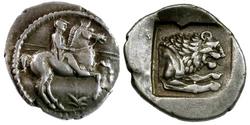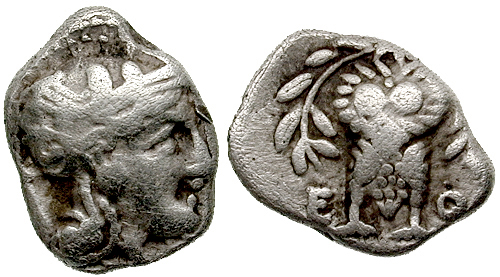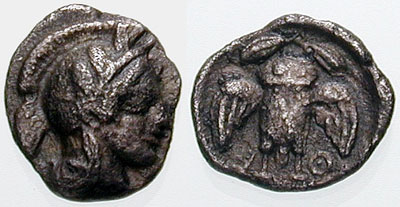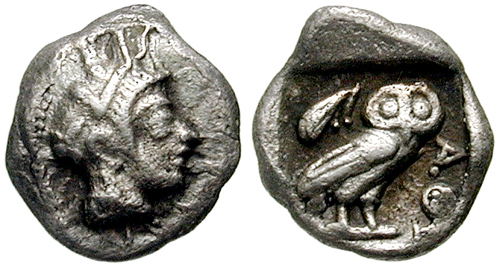An obol is an ancient Greek coin that has one-sixth the value of a drachma.
The first silver obols were minted in Aegina, most likely sometime after 600 BCE. Previously, the unit of currency was iron cooking-spits. One obol became the equivalent of one spit.
Obols in Aegina were produced from one gram of silver. Though some other parts of Greece adopted the obol, the amount of silver was different in obols of different regions. In Athens an obol would weigh only .72 grams, while in Corinth it weighed .42 grams.
There were several coins minted which were variations of the obol. Silver obols and triobols (three obol pieces) were among the most common coins in Thessaly, while central Thrace minted large numbers of tetrobols, triobols, and diobols.
Macedonia not only had coins of different obol values (the most common were octobols and tetrobols), but had two different types of tetrobols—heavy and light—which were measured on different standards. Light tetrobols were composed largely of a base metal and it is therefore hypothesized that they were intended to be used only within Macedonia as a “token currency.” Heavy tetrobols, conversely, were composed of pure metal and were therefore acceptable for trade with other regions. This theory is supported by the fact that many more heavy than light tetrobols have been found in the outside region of Olynthos. The light tetrobol can also be distinguished because on its obverse there is an image of a horse standing alone, while the heavy, like most other Macedonian denominations, depicts a horse with a rider or an attendant.
Below: A heavy tetrobol depicting horse and rider. (http://www.ancientimports.com/cgi-bin/category.pl?id=5)

Many areas had a significant change in coinage over time. In the fifth century Athens minted coins worth three obols, one and one-half obol—also known as the trihemiobol, one obol, and one-half obol—called a hemiobol. By the fourth century, other coins valued at as little as one-eighth obol (one chalkous) were minted. Additionally, the fourth century brought with it the introduction of bronze coins. These were much more convenient for smaller denominations, since a bronze coin would be much larger than its silver equivalent and therefore more difficult to lose.
Though variations on the obol were largely distinguished by size, in some cases the type was also different for different coins. Athens, for example, depicted an owl standing right on most of its coins. The triobol, however, shows an owl from the front, and a trihemiobol displays an owl with spread wings.
Below: The triobol, the trihemiobol, and the hemiobol can be distiguished by subtle differences in designs of the owls on the reverse. (http://www.wildwinds.com/coins/greece/attica/athens/)



Sources:
Jenkins, G.K. Ancient Greek Coins (New York: G.P. Putnam's Sons, 1972).
Kraay, Colin M. Archaic and Classical Greek Coins (London: Methuen and Co. LTD, 1976).
